Aug 27, 2019 | wedding planning
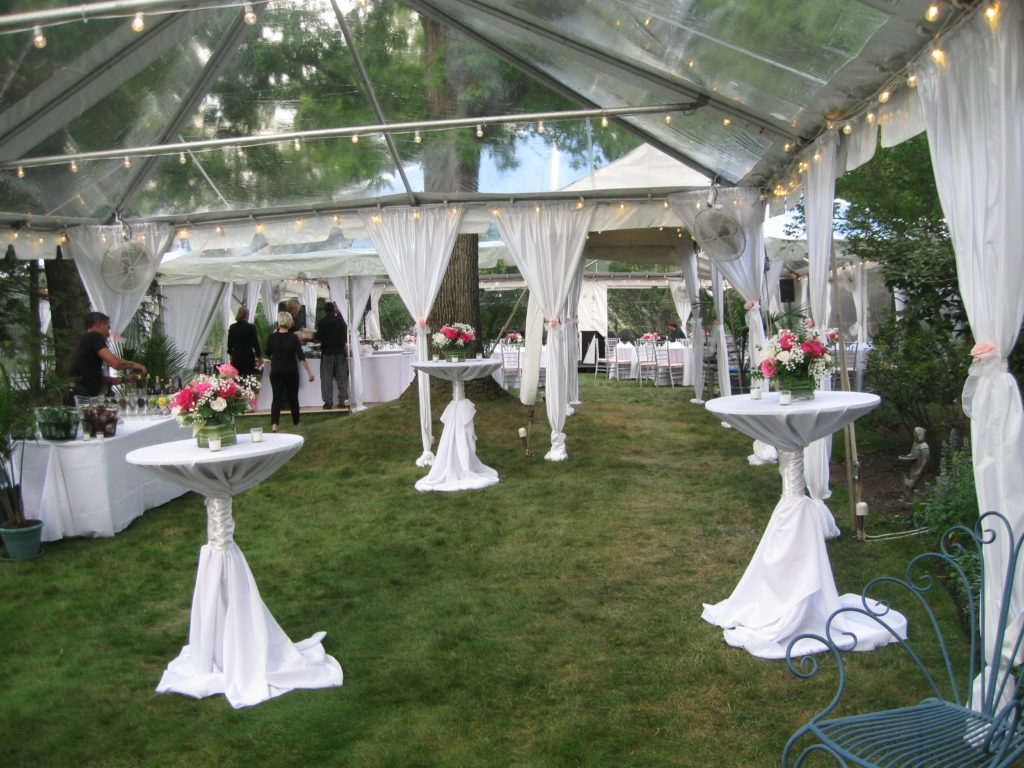
This is what I would call a nice tent!
Well, it happened again: I am back from spending a lot of time helping my clients. But every time I take a deep dive into a job like that, I learn or remember something of importance. This time, I was helping clients with their big, tented backyard wedding reception, so I did some serious thinking about that process.
My clients were a suburban couple with a large yard that had just enough room to hold a tent where they could entertain about 130 people. It was a big tent–or, really, one very large tent and a series of smaller tents to fit the shape of the space. I helped them find a really good tent and rental company, which was also able to provide lighting, fans, tables and chairs, a generator, and draping for the legs of the tents. It looked stellar (see the photo above!)
These clients didn’t want to talk budget with me too much, so I don’t know if their choice to have the party at home was motivated by financial concerns, but I do know that a lot of people consider having a tented party at home because they think that they will have more control over the costs than if they rented a venue.
What I’m here to do today is debunk that idea completely. If you are looking for an affordable venue, you are much better off renting an all-inclusive hall (that will provide tables, chairs, and dishes) than setting up a tent in your backyard. Here’s why:
When you use your yard as your party venue, you basically have to import an entire infrastructure to support your event. You’re putting up the hall (the tent); providing electricity (probably a generator unless your house has a lot of excess electrical capacity (most don’t)); decorating (okay, so you might do this, anyhow, depending on the hall); providing restrooms (unless, again, you have a lot of those in the house); renting all the furniture; and possibly also providing garbage disposal. With the possible exception of decoration and, sometimes, furniture, those are all things that are provided gratis by pretty much any event venue. You also have to think about parking, which is often also part of the package when you rent.
Not only are all those things a lot of work, but they also can cost a substantial amount of money. The smallest high-quality generator I could find for an event was over $2,000. If you add the price of an onsite technician (which I highly recommend), you’re at close to $3,000. And that’s just for the electricity, alone!
By comparison, there are very nice venues that rent for a six-hour event on a Saturday for just barely more than what you’d pay for a generator alone. The one I’m thinking of includes in their rental price: all tables and chairs, including highboys and cabaret tables; all dishes and silverware; a commercial kitchen; newly renovated restrooms; a stage; portable bars; wi-fi; parking; and air conditioning. For very modest fees, you can also add: a sound system, a projection screen, a baby grand piano, and a fire in their wood-burning fireplace. If you add it all up, in this scenario, renting the hall would be exponentially less expensive.
I’m not saying there aren’t good reasons to have a tented backyard party. Sometimes, that’s the thing you want for whatever reason, and I’ll always be happy to help you arrange for whatever you need to make it happen. Just don’t go into it thinking that it’s the least expensive way to have your party.
Jul 29, 2019 | wedding planning
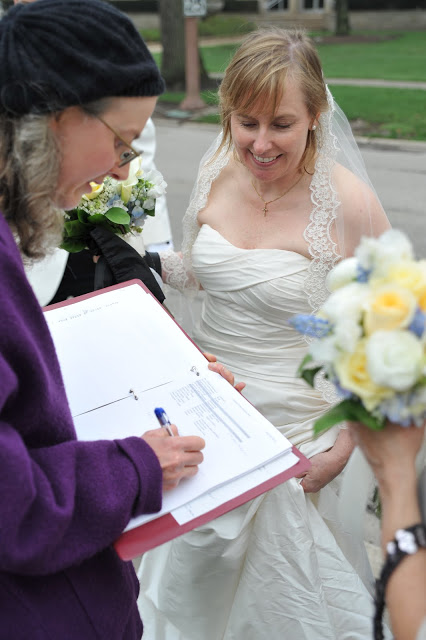
Here I am checking things off the list I made at the walk-through.
Whether I am doing full planning for my clients or coordinating the wedding, I always do a walk-through at the venue with them. Lately, I’ve been getting more questions about the walk-through, so let me (ha!) walk you through the process.
Ideally, I like to have the couple, the caterer, and a representative from the venue all there at the same time. I prefer not to have anyone else there. Sometimes the couple will invite family members, members of the wedding party, the officiant, the DJ, the photographer, the florist, etc. But I’ve noticed that the more people you have in the room, the longer it takes. Yes, it’s great to have a meeting of the minds in person, and it’s one way to solve problems in advance. But I can also accomplish the exact same end via email and phone once we’ve walked through the venue.
There are always certain decisions that need to be made at a walk-through: Where do you want the ceremony set up? Where and when do you want certain things to happen (toasts, cake cutting, dances)? What are we going to do in case of bad weather? Usually, the caterer has a long list of questions they need answered, and the venue has a shorter list. I have all the same questions, so we go through the day step by step to ensure that everyone understands what is planned.
Out of this, I make a master schedule for the entire day, and someone (venue, caterer, or me) makes the ground plan and furniture layout. (It all depends on the situation who does it, but it doesn’t matter as long as it gets done!) I also make a list of the tasks I am responsible for on the wedding day, and a list of items I’ll need to keep track of. I also usually end up with a list of questions for other vendors that I spend the next week or so getting answered.
In all of this, my function is to consolidate and organize and transmit the information to everyone who needs it. I’m the central clearinghouse for everything. And that’s why I always say, “Tell your planner everything you want and everything you are thinking.” That way, I can make sure that things happen just the way you are imagining they will go.
Jul 15, 2019 | wedding planning
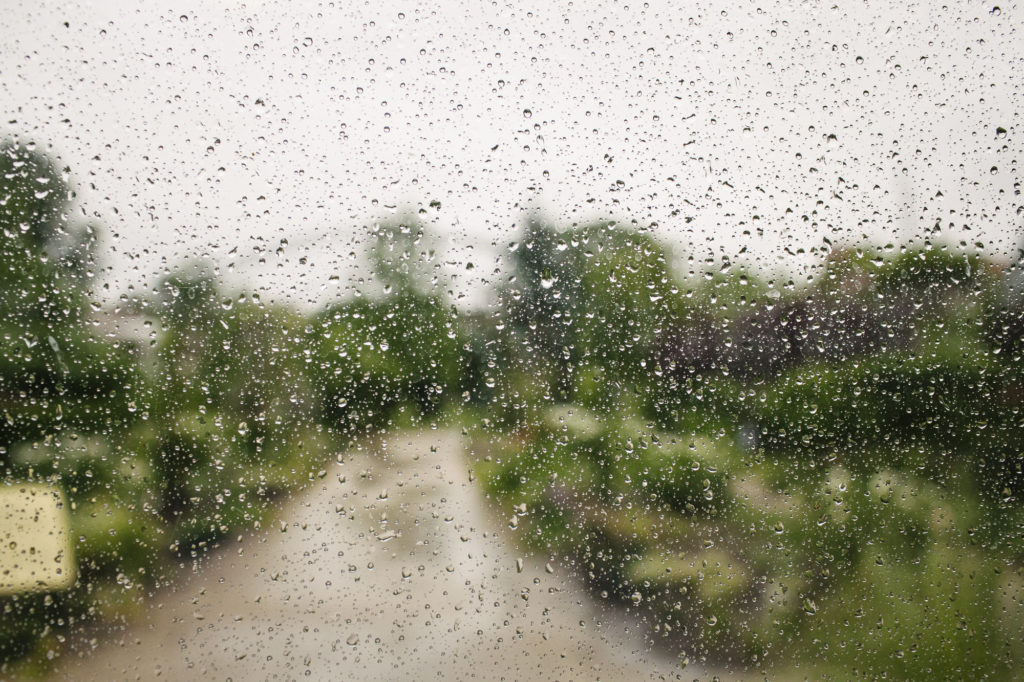
Actual view out the window looking at where the ceremony was supposed to take place. Photo by Becca Heuer Photography.
This is a tough one to think about. I like to stay positive, but I can’t help noticing that it’s getting harder and harder to do outdoor events, due to changes in the climate. One of the things that climate change brings is more instability in the atmosphere. I’ve noticed that that can make weather prediction trickier.
I’m no meteorologist, but watching the weather has been a hobby of mine for a very long time. I enjoy looking at the weather radar maps and at the weather forecast maps, and making my own predictions about future conditions. Up until recently, I was pretty accurate. Given enough information, I could make a good call on whether a given event was going to be able to be outside, or not.
On a recent weekend, I had two outdoor weddings on a Saturday. I’m used to being able to make a weather call 24-48 hours before an event. Well, that didn’t work this time. Starting about 36 hours before the event, the weather forecast changed drastically about every six hours. First, it was a high chance of rain; then a low chance; then back to a high likelihood; and then low again. The only thing that wasn’t predicted was what happened: clear skies and sunny. (I guess that falls under “very low chance of rain”??)
One wedding that day had to make their rain call the day before, when it looked like there would almost definitely be rain. They had the wedding indoors, even though the day was gorgeous. The other wedding didn’t have to make the call until about 3 hours before the ceremony time. By that time, it was a pretty sure thing that it was not going to rain, so they managed to have their ceremony outdoors.
So, if you’re planning a wedding, or any other outdoor event, just be sure to have a solid rain plan, and be ready to use it at a moment’s notice. It seems that there are times when it may be hard to tell what is going to happen.
Jul 8, 2019 | wedding planning
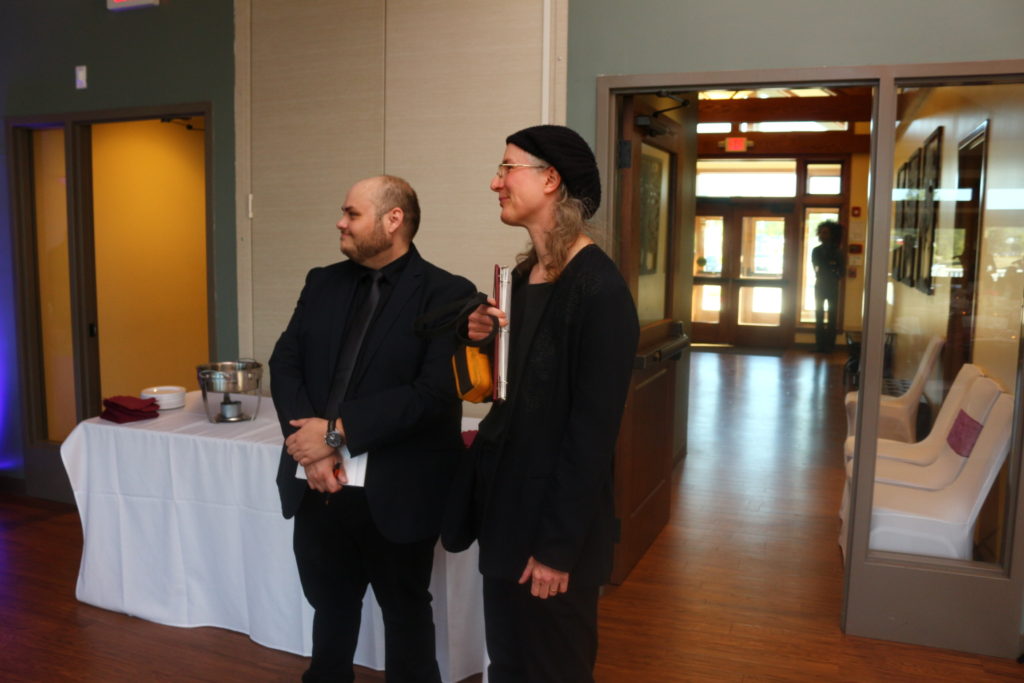
Here is your planner/coordinator team at work. Don’t be fooled: Sometimes we’re working hardest when we are standing still! Photo courtesy of Godzroqk Designs.
So, you are getting married, and you’ve never done this before. You don’t know: Who is in charge of running things on the day of your wedding? Is it the venue manager? The caterer? Your planner or coordinator?
The answer is: Yes!
Now, I’m not going to promise that my experience will predict what every other wedding team will do; different people work different ways. But here is how I see it:
The venue manager is there to protect the interests of the location. Whether it’s a historic mansion or a downtown loft, they want to have someone there to make sure the physical location (and its reputation!) remain intact. They are also invaluable as a source of information on how the space works best–and where to find things. They are your first Very Important Team Member (VITM).
The caterer is not just in charge of food. The caterer is also in charge of the staff that makes 90% of your event happen. They set up chairs for the ceremony (unless the venue does that), take them down, move them to the reception location, set up and set the tables, set up and stock the bar, serve, tend bar, and clean up at the end of the night. So, if something needs to happen in any of these areas, your caterer is in the picture. Your Caterer is #2 on the list of VITMs.
Finally, you have your planner or coordinator. They work exclusively for you, representing your interests, in so far as you have communicated them to her. Ideally, your planner, caterer, and venue manager all work together as a team.
The one person who should have the most information, though, is your planner–who also has the scoop on your florist, DJ, officiant, photographer, bus company, hair and make-up people, and all the other professionals you have hired.
The way I like to work is to gather all the information possible from all of your vendors, and then share it with each of them. That helps to keep everyone on the same page. It means I can answer questions from each vendor about what all the other vendors are doing, and I can coordinate among them for maximum efficiency.
If the bus is running late getting the guests to the ceremony, I can alert the caterer that we are running behind. When the videographer needs to get a sound feed from the DJ, I make sure they are working together. And a thousand other little things that make the day flow.
What this means for you when you are planning your wedding is that you should always keep your planner or coordinator in the loop. You will probably never see 90% of the work I do for your wedding because it mainly takes place under the radar. But the more you tell me about what you want and what you have planned, the better I can make it all happen.
Mar 18, 2019 | wedding planning
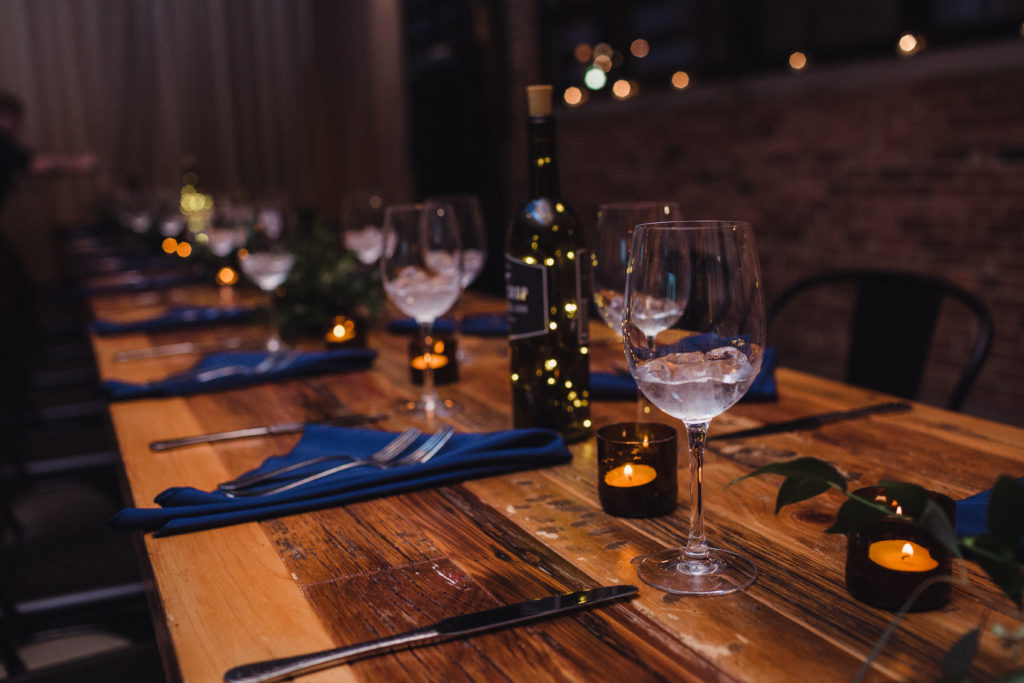
Tea lights in cut-off wine bottles are both pretty and safe. Photo by The Still Life Photography.
I think there have been candles of some sort at every single wedding I’ve ever worked on. It seems that everyone loves candles! Everyone, that is, except maybe the fire marshal. Perhaps it’s because most of my work is in Chicago–which has the strictest fire code in the country–that I’ve run across this issue more than once.
If you’re planning your wedding or party decor, give some thought to this: All flame must be enclosed. No open flames are allowed. That’s what the Chicago city fire code says; that’s what a great many responsible venues put into their contracts (even outside the city); and that is the only safe way to have candles at your event.
I’ve seen this play out a couple of different ways. I recall a reception at a restaurant where the restaurant itself had a great many unenclosed pillar candles on the tables. I watched in horror as two candles on the gift table were knocked over onto the floor. We got lucky that time: They extinguished themselves as they fell and didn’t light anything on fire. I did some re-arranging after that to avoid future problems. It really opened my eyes to the problem of open flame.
Another time, a bride wanted to have tapers in crystal candlesticks on the head table. It would have looked spectacular! And the venue put a stop to it before they were even lit. The bride had to be content with unlighted tapers.
There are lots of ways to have safe (and legal) candles at a large event. Votive candles in glass are pretty typical. Tea lights in glass are also used frequently (but they don’t burn as long as votives). If you want pillar candles, try hurricane lanterns or other kinds of lanterns. Lanterns with colored glass are a nice touch. You can even put a taper in a lantern, if you like.
The other option is flameless candles, such as the newer LED candles. I’ve mostly seen pillar candles and votives made this way, and the best ones are almost indistinguishable from real candles. And they can be free-standing without glass. Use them to line the aisle or light the way up stairs. Not only will they not set anything on fire, they also don’t burn out or put soot into the air.
I’ll admit that fire safety is probably not the first thing on the mind of anyone planning a big party or a wedding. So, please consider this your reminder to put safety first and think about how to have the beauty of candles safely.
Feb 4, 2019 | Eco-Friendly Events, wedding planning

Popcorn wedding favors? Yes, please! There were none of these left at the end of the night.
Here is one fairly easy way to make your wedding (or other party) more eco-friendly: Think about your wedding favors.
The greenest thing you could possibly do with favors would be to have no favors at all. After all, if there’s no favor, then there’s no waste. But that is not the way everyone wants to have things. So, if you are going to give favors, here are three things to consider: the type of favor, the place of manufacture, and the quantity to buy.
Probably the least sustainable type of wedding favor is the small object imprinted with the couple’s name and wedding date, especially if it is something plastic. Obviously, there are exceptions, but these types of things are the things that most people throw out after a while. It’s a lot of waste. A small object that is recyclable, compostable, or growable is a step in a cleaner direction. Something consumable or really useful might be even better. Food and beverages probably won’t go to waste–although you might want to give some thought to the type of containers they are in. Plastic cupcake boxes or nylon almond bags are likely to generate waste. Glass bottles are more likely to be recycled. Donations in lieu of favors sidestep the issues of waste entirely–and you could give money to an organization that works on issues of sustainability, if that is your wish. There is a whole range of possibilities here (and others I’m sure I’ve missed) that allow you to make your celebration more eco-friendly.
If you do decide to give your guests a small token, consider where and how it is made. Things that are cheaply made overseas have to be shipped here, which is a lot less sustainable than things made locally. You might also want to consider the ethical issues of cheaply made goods: They are generally made by people (sometimes children or prisoners) who are paid less than a fair wage. While it often costs more to buy from a local producer, at least you can verify the conditions of manufacture to be sure the creators are being paid fairly.
The other thing to consider is how many things to buy for your guests. In my experience, there are almost always favors left over at the end of the night (unless it’s a very popular food item). Often, guests will take one favor per household, rather than one per person. Some people just don’t want them. When you are deciding what kind of favor to get, take this fact into account. If you buy one per guest, you may well have to figure out what to do with the leftovers. You might want to purchase fewer than the number of guests so you don’t have to solve that puzzle. Or be sure to buy something that is easy to donate or resell.
While there are much bigger things you can do to green your wedding, this one is fairly easy and can be inexpensive. It’s something within the reach of many more people than, say, serving only organic local food. So, if you want to have a more sustainable celebration, you can start here. It’s always better to do something than to do nothing.
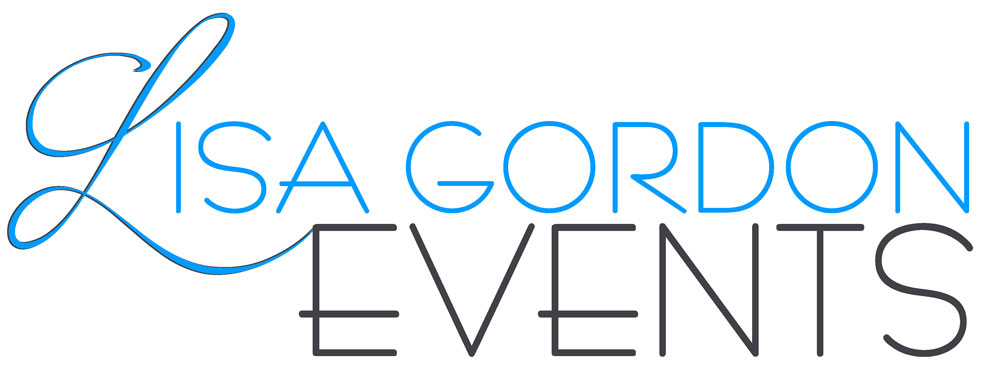






Recent Comments